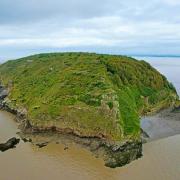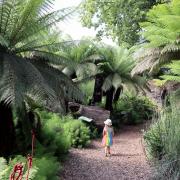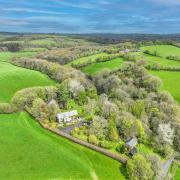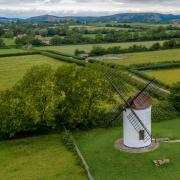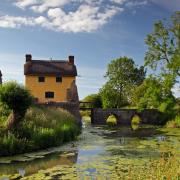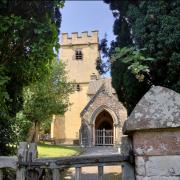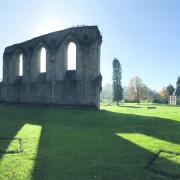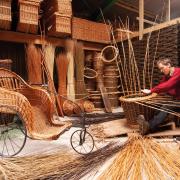We give you all the information you need to plan a great day trip to one of these beautiful gardens, all of which are free for National Trust members.
When the weather's fine, there's nothing better than a walk in the British countryside. The National Trust pride themselves on maintaining some of the most beautiful properties and gardens in the country, all of which the public can access the whole year round. If you are a National Trust Member, you can visit as many as you like for free, otherwise there is usually a small fee for entry. But don't let that put you off, each of these 8 locations is well worth the money and are guaranteed to amaze with their beautiful flora, fauna, and views.
Some properties may not be fully operational at this time and may require you to book ahead. Please follow social distancing rules where appropriate.

This Tudor manor house is surrounded by breath-taking walled gardens and orchards of all varieties. The famous garden designer, Gertrude Jekyll, was consulted on designing the gardens in the 1920s during restoration by the last owners of the property. By this time, Jekyll was almost completely blind and yet incredibly still managed to advise on what would flourish in the limey soil. Her plans are still used today to keep the gardens aesthetically fitting.
Not only does the house have a working moat and parklands, but the gardens are sectioned into a rose and iris garden, a lily garden, an apple orchard, and a vast kitchen garden. At the end of August, the harvest will begin which is a lengthy piece of work and can take almost three months to complete! We recommend taking a stroll along the Pergola Walk during your visit which is covered in climbing plants and will take you past some of the most beautiful parts of the gardens.
As well as the house and gardens, there is also a shop, book barn, kiosk, car park, and toilets on site. Dogs are welcome on the wider estate, but only assistant dogs can enter the inner gardens.

Whilst it's a great deal smaller than many of the properties on this list, Coleridge Cottage is no less of a great place to visit this summer. As the name suggests, this was the home of the great Romantic poet, Samuel Taylor Coleridge, whilst he was writing some of his greatest works. After wandering the cottage, you can relax in a beautiful wild garden that has been carefully cultivated during the restoration efforts.
Due to the size of the property, amenities are limited at this time. Picnics are welcome or you could pop across the road to the Ancient Mariner which is also where you can park.

For more than 600 years, the Luttrell family lived at Dunster with the current structure being completed in the 19th century. The grounds of the castle are truly awe-inspiring with more to explore than you could fit in on one visit alone. The terraced gardens are home to an impressive collection of subtropical plants, whereas down below is a wooded garden by the river which is home to a natural play area. It's no wonder that this property is so popular with families as well as walkers and avid gardeners.
Dogs are welcome everywhere at Dunster Castle except inside the building itself and the tearooms and it's a veritable paradise for your four-legged friend with plenty of walking routes. As well as the tearoom, there is also a café, shop, toilets, and parking.

This austere grey manor was the family home of Henry Lyte, most famous for his work translating the Niewe Herball book on herbal remedies. Therefore it's not a surprise that the natural world is a big part of this property's charm. The property changed hands several times after Lyte's death and the original gardens were lost to farming. The last owners, Sir Walter Jenner and Lady Flora, took a unique stance with the formal gardens which was Arts-and-Crafts inspired. This means the gardens are segmented into 'rooms' separated by yew hedges and stone walls, each reflecting a different mood or purpose.
But that's not all, on your visit you can walk the wider estate through woodland and open fields. There are three recommended walks which will help you see much of the countryside that is home to many rare species.
You can walk your dog in the wider estate but not in the formal gardens. You may want to keep them on a long lead as there is often cattle in the fields depending on the time of year. Food and drink are available at the tearooms and there are toilets plus ample parking on site.

The National Trust describe our next property as "a masterpiece of Elizabethan Renaissance architecture and design". Built more than 400 years ago, no expense was spared in the craftmanship and it has stood the test of time remarkably well. Inside the house, The Long Gallery is a particular highlight of any visit. The longest of it's kind in the country, it is also home to more than 60 Tudor and Elizabethan portraits on loan from the National Portrait Gallery.
Outside, the property is just as impressive. It is one of the few houses of its time that has kept the compartmentalised style that stately homes of the period were renowned for. Enjoy the vibrant borders of the East Court, walk between the yew hedges of the North Garden, and relax on the soft grass of the Cedar Lawn (anyone fancy a picnic?). Top off the day with a walk in the beautiful parkland and keep an eye out for local fauna such as deer.
Dogs can go anywhere on the property except inside the house, café, and shop.

Not far from the hustle and bustle of Bath, visitors can enjoy an idyllic and calming walk around the beautiful valley of Prior Park. Constructed by local entrepreneur Ralph Allen, with advice from 'Capability' Brown and the poet Alexander Pope, the park is home to one of only four Palladian Bridges left in the world.
The park is made up of a mix of woodlands and meadows with an Iron Age hill fort, Roman settlements, and 18th-century follies to look out for as you go. Dogs are welcome on leads and there are toilets and a café on site (open weekends and school holidays). For parking, you will need to go into the city and walk across to the park.
Currently, work is being done to preserve and restore much of the parkland so you may notice slight changes on your visit. For example, the lake under the Palladian Bridge has been drained whilst they work on a damming project. Don't worry however, you're sure to still have a wonderful day out.

Every Saturday and Sunday, Tintinhull opens its gardens to the public for peaceful walking and relaxation. The garden was created by a woman called Phyllis Reiss who designed the area so that each plant "harmonised with the soft, warm colour of Ham stone and... meant there was something to see from every window of the house".
There is also an orchard adjacent to the house and gardens where you can walk your dog although they can't come in the main garden unless they are a service animal.
If you fancy something a little different, it's actually possible to rent the house that accompanies the house for a short break. You can find the full details here.

Not far from Bristol you'll find the impressive Victorian Gothic Revival house of Tyntesfield with its vast gardens and parkland. There's much to explore including flower-filled terraces, an empty lake, extensive woodland, and a productive kitchen garden.
Whilst today the property may seem extravagant, at the time of its completion, it was simply a functioning family house. As devout Anglo-Catholics, the Gibbs family wished to express their beliefs through their home. The turrets and spires are like something out of a fairy-tale and children will love exploring all the nooks and crannies it has to offer.
Dogs are welcome on short leads in all areas except the Kitchen and Rose Gardens. As well as the house and gardens, you'll also find the Cow Barn café, shop, and bookshop to browse.





